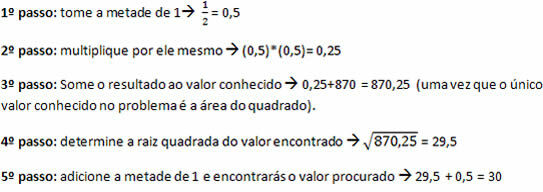The first record of the 2nd degree equation that is known was made by a scribe, in 1700 BC. C., approximately, on a clay tablet, whose presentation and form of resolution was rhetorical, that is, through words, considered as a "recitation infallible mathematics" to solve such an equation and which provided only a positive root (negative roots only entered the mathematical context from the XVIII century).
We are talking about a period much earlier than the discovery of Baskara's formula. According to Eves, in her book “Introduction to the history of mathematics”, the Mesopotamians presented the first equation of the second degree as follows:
"What is the side of a square if the area minus the side is 870?"
Calling the side of the frame x, the problem would actually produce the equation: x2-x=870.
For problems of this nature they had the following "math recipe”:
“Take half of one, multiply by itself. Add the result to the known value, then determine the square root of the value found and finally add half of one and you will get the value you are looking for.”
Let's apply the Babylonian method to solve the problem posed above.

So the side of the square measures 30.
Checking the answer found:
The problem posed was: “Which is the side of a square, if the area minus the side is 870?”.
We found that the side measures 30, so the square's area is 900. Making the area minus the side→ 900 – 30 =870. It turns out that the answer is really correct.
Another example: Solving the equation x2-x=12 or x2-x-12=0.
Solution:
Half of 1 = 0.5
Multiply by itself: (0.5)*(0.5) = 0.25
Add the result to the known value: 0.25+12 = 12.25
Determine the square root of the found value:

Add half of 1 and you will find the value you are looking for: 3.5+0.5=4
So the positive root of the equation is 4.
Attention: the "recipe" proposed by the Babylonians is only valid for 2nd degree equations whose constants a and b are equal to 1.
By Marcelo Rigonatto
Specialist in Statistics and Mathematical Modeling
Source: Brazil School - https://brasilescola.uol.com.br/matematica/equacao-2-o-grau-sem-uso-formula-baskara.htm


